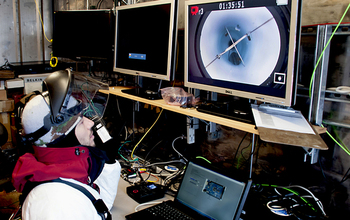News Release 17-070
Methane-eating bacteria in lake deep beneath Antarctic ice sheet may reduce greenhouse gas emissions
Samples from subglacial Lake Whillans indicate ecosystem acts as 'methane biofilter'

Ken Markoff of the University of California, Santa Cruz monitors the WISSARD borehole in 2013.
July 31, 2017
This material is available primarily for archival purposes. Telephone numbers or other contact information may be out of date; please see current contact information at media contacts.
An interdisciplinary team of researchers funded by the National Science Foundation (NSF) has concluded that bacteria in a lake 800 meters (2,600 feet) beneath the West Antarctic Ice Sheet may digest methane, a powerful greenhouse gas, preventing its release into the atmosphere.
As part of the NSF-funded Whillans Ice Stream Subglacial Access Research Drilling (WISSARD) project, the researchers successfully drilled through the ice sheet in 2013 to reach Lake Whillans. They retrieved water and sediment samples from a body of water that had been isolated from direct contact with the atmosphere for many thousands of years.
The prevalence of methane-consuming bacteria in the upper lake sediment suggests a "methane biofilter" prevents the gas from entering the subglacial water, where it can eventually drain into the ocean and be released into the atmosphere. The bacteria obtain energy from digesting the methane.
The team, which includes researchers from Montana State University, Louisiana State University and Aberystwyth University in Wales, used a combination of measurements of methane concentrations and genomic analyses to describe how lake bacteria chemically convert methane in a way that reduces the warming potential of subglacial gases during ice sheet retreats.
The scientists say that if their analysis is correct, it could mean that a large reservoir of methane thought to lie under the vast West Antarctic Ice Sheet -- which encompasses 25.4 million cubic kilometers (6.1 million cubic miles) of ice -- is less likely to be released into the atmosphere.
They also note that because methane is such a potent greenhouse gas, "understanding its global sources, sinks and feedbacks within the climate system is of considerable importance" to the scientific understanding of the larger global climate picture.
The team published its results today in the journal Nature Geoscience.
Their findings describe how biological processes in the sediments at the lake bottom transform the methane into carbon dioxide. This area, where the water meets the lake bottom, may be vital to the success of ecosystems of subglacial lakes, which are permanently cut off from atmospheric heat and sunlight.
"Not only is this important for the global climate, but methane oxidation could be a widespread means of life for microbes in the deep, permanently cold biosphere beneath the West Antarctic Ice Sheet," said Alexander Michaud of Montana State University, the lead author on the paper.
Studies of subglacial lakes may contain clues as to how microbial life might persist in the outer solar system, where ice-covered moons orbit the larger planets.
In recent decades, researchers, primarily using airborne radar and satellite laser observations, have discovered a continental system of rivers and lakes -- some similar in size to North America's Great Lakes -- beneath the Antarctic ice sheet.
Only a small portion of these lakes have been explored, largely to prevent contamination of a pristine ecosystem that may be interconnected in unknown ways. WISSARD researchers used a specially designed hot-water drill to make certain that the subglacial environment would remain pristine, and to prevent contamination of samples.
Results presented in the Lake Whillans paper imply that a vast microbial ecosystem capable of transforming key geochemical elements lies beneath the Antarctic ice sheet.
The WISSARD project was preceded by ongoing field research that began as early as 2007 to place this individual lake in context with the larger subglacial water system. The NSF's U.S. Antarctic Program funded, and provided the complex logistics, for those investigations and the sampling of Lake Whillans.
"It took more than a decade of scientific and logistical planning to collect the first clean samples from an Antarctic subglacial environment, but the results have transformed the way we view the Antarctic continent," said John Priscu of Montana State University, a co-author on the paper.
In addition to Michaud and Priscu, the research team included Trista Vick-Majors, John Dore and Mark Skidmore from Montana State University; Amanda Achberger and Brent Christner from Louisiana State University; and Andy Mitchell from Aberystwyth University in Wales.
-NSF-
Media Contacts
Peter West, NSF, (703) 292-7530, email: pwest@nsf.gov
Evelyn Boswell, Montana State University, (406) 994-5135, email: evelynb@montana.edu
Co-Investigators
John Priscu, Montana State University, (406) 994-3250, email: jpriscu@montana.edu
The U.S. National Science Foundation propels the nation forward by advancing fundamental research in all fields of science and engineering. NSF supports research and people by providing facilities, instruments and funding to support their ingenuity and sustain the U.S. as a global leader in research and innovation. With a fiscal year 2023 budget of $9.5 billion, NSF funds reach all 50 states through grants to nearly 2,000 colleges, universities and institutions. Each year, NSF receives more than 40,000 competitive proposals and makes about 11,000 new awards. Those awards include support for cooperative research with industry, Arctic and Antarctic research and operations, and U.S. participation in international scientific efforts.
Connect with us online
NSF website: nsf.gov
NSF News: nsf.gov/news
For News Media: nsf.gov/news/newsroom
Statistics: nsf.gov/statistics/
Awards database: nsf.gov/awardsearch/
Follow us on social
Twitter: twitter.com/NSF
Facebook: facebook.com/US.NSF
Instagram: instagram.com/nsfgov


